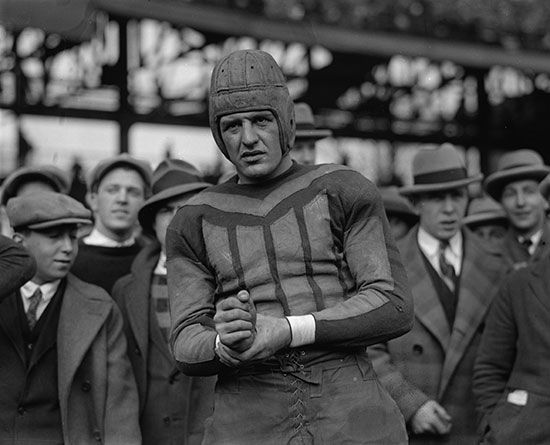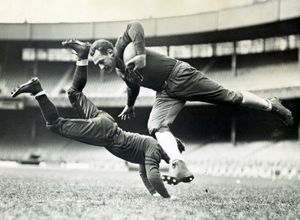Red Grange
Our editors will review what you’ve submitted and determine whether to revise the article.
- Byname of:
- Harold Edward Grange
- Born:
- June 13, 1903, Forksville, Pennsylvania, U.S.
- Died:
- January 28, 1991, Lake Wales, Florida (aged 87)
- Awards And Honors:
- Pro Football Hall of Fame (1963)
- Pro Football Hall of Fame (inducted 1963)
- 2 NFL championships
- 2 All-Pro selections
News •
Red Grange (born June 13, 1903, Forksville, Pennsylvania, U.S.—died January 28, 1991, Lake Wales, Florida) was an American collegiate and professional gridiron football player and broadcaster who was an outstanding halfback, known for spectacular long runs that made him one of the most famous players of the 20th century. He was an important influence in popularizing professional football.
Grange was a star football player at Wheaton (Illinois) High School before entering the University of Illinois in 1922. There he played football during the 1923–25 seasons and was selected as an All-American halfback each season. He became a national idol in 1924 when he turned in one of the most sensational single-day performances by an athlete in sports history. Against a highly rated Michigan team, Grange ran for touchdowns of 95, 67, 56, and 44 yards in the first quarter of play. In the second half he scored a fifth touchdown and threw a touchdown pass in a 39–14 Illinois victory. Grange was nicknamed the “Galloping Ghost” for his blinding speed and elusive running style.
The following year Grange delivered another spectacular performance in the East, where some sportswriters questioned his ability as well as the quality of Midwestern football. He led Illinois to a 24–2 victory over Pennsylvania, scoring three touchdowns and gaining 363 yards. After his last college game in 1925, Grange dropped out of school and signed a professional contract with the Chicago Bears of the National Football League (NFL). Amid much controversy over his decision to leave school and become a professional athlete, Grange drew huge crowds to the Bears’ final games that NFL season and on an extended barnstorming tour. He demonstrated the potential for the growth of pro football, a game that was not highly regarded at the time by many sports fans.

In 1926 Grange played for the New York Yankees in the American Football League, which he and his agent, Charles C. Pyle, founded. The league folded after one season, and the Yankees joined the NFL in 1927. Early that season Grange sustained a serious knee injury, and he sat out the 1928 season; he then returned to play for the Chicago Bears (1929–34). After his injury Grange was no longer the explosive runner he had been, but he remained a leading rusher in the NFL for a number of seasons and was also an excellent defensive back.
After his retirement from football, Grange became the first well-known athlete to become a successful radio and television broadcaster, with a career that spanned 25 years (1934–69). Grange was a charter member of both the College Football Hall of Fame (1951) and the Pro Football Hall of Fame (1963).




















